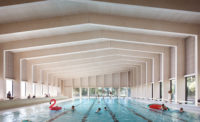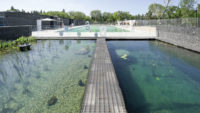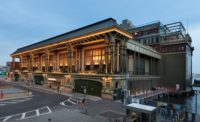Like a splash of cold water, POOL Aoyama is a refreshing surprise. Previously an indoor swimming center, this flexible interior is equally suited for retail or gallery use by day but turns into party central by night. While its design is the product of Nobuo Araki, a Tokyo architect whose firm, The Archetype, has a penchant for renovation, the event-space concept was developed in connection with the music mogul cum design guru Hiroshi Fujiwara and the apparel company JUN Group. Today the smell of chlorine is long gone, but the atmosphere of the vintage pool remains in the air.
For the sake of direct street access, Araki uprooted the garden and replaced it with concrete stairs that ascend to the existing glass doors he converted to POOL Aoyama's entrance. These open onto the original tile-clad deck. Ringing the pool, this narrow walkway leads to the changing area, now repurposed as fitting and storage rooms, a new cashier counter that doubles as a beverage bar, and wood stairs on either side that descend to the pool bottom.
In accordance with the client's directive, Araki went to great lengths to preserve the pool. In addition to leaving steel ladders and rusty drainage grills in place, he kept its painted concrete walls as they were, reasoning that chips and cracks are part of the artifact. But the floor was another matter. 'Since it slopes about a foot, it can be unsettling to walk on,' explains Araki. He solved this problem by covering the steep portion with two ½-inch-thick sheets of clear glass supported by a stainless steel grid of varying depth to absorb the level change. 'This floor is so strong, you could drive a car on it,' jokes Araki. While the glass's reflectivity evokes water, a nonslip coating renders the surface appropriate for walking or dancing.
Overhead, Araki left the coarse concrete exposed, and suspended from the ceiling curved metal HVAC ducts painted nautical white, adjustable track lighting, and striped sailcloth awnings to modulate the existing skylights in the portion that juts into the garden. Matching curtains cloak clerestory windows on the room's long walls.
To complete the transformation, Araki finished the space with pool-like details and movable parts to enable quick installation or changes in display. Resembling poolside grab bars, stainless steel tubes encircling the pool deck and ceiling can support hooks for hanging merchandise, white laminated shelf units, and glass accessory cases. Individual plastic benches designed by Araki and made by a swimming-supply company look as though they have always been there.
Rough-edged and raw-surfaced, this project reflects a recent trend among some younger architects toward adaptive reuse. 'Previously, people equated old things with poverty,' comments the architect. 'But my generation doesn't share those associations.' For many of his peers, the country's scrap-and-build culture no longer holds water: 'It's so wasteful,' laments the architect. Yet change comes slowly in Japan. 'POOL Aoyama will probably disappear in the future,' concedes Araki. 'That's just Tokyo.'
PeopleOwner: JUN Co., Ltd. Architect: Personnel in architect's firm who should receive special credit: Project architect: Takanobu Matsushita Engineer(s): Lighting: On&Off / Shinji Yamaguchi General contractor: Photographer: Size: 1,750 square feet Cost: Withheld Completion Date: April 2014 |
ProductsInterior finishes Furnishings Add any additional building components or special equipment that made a significant contribution to this project: Custom Glasswork: ACTIVELIFE COMPANY LIMITED. |









Post a comment to this article
Report Abusive Comment